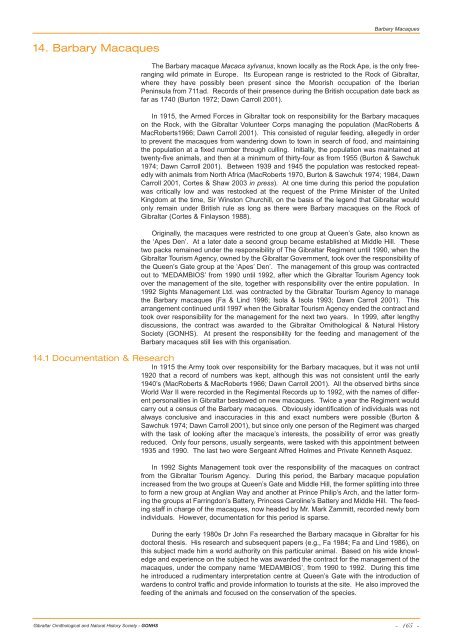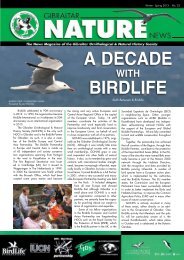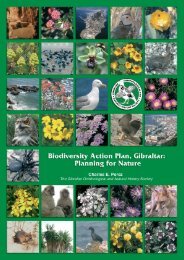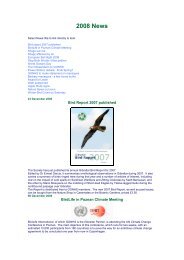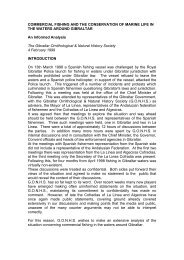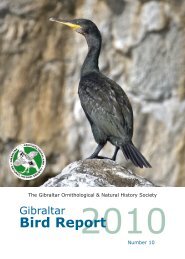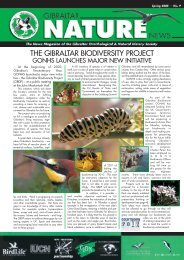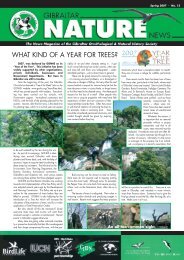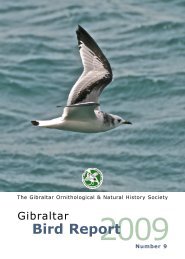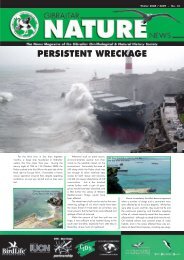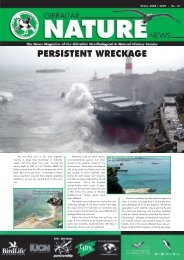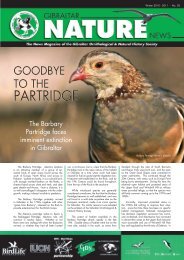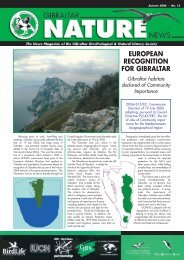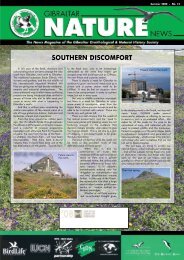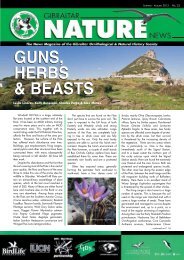Upper Rock Nature Reserve: A Management and Action Plan
Upper Rock Nature Reserve: A Management and Action Plan
Upper Rock Nature Reserve: A Management and Action Plan
You also want an ePaper? Increase the reach of your titles
YUMPU automatically turns print PDFs into web optimized ePapers that Google loves.
14. Barbary Macaques<br />
Gibraltar Ornithological <strong>and</strong> Natural History Society - GONHS<br />
Barbary Macaques<br />
The Barbary macaque Macaca sylvanus, known locally as the <strong>Rock</strong> Ape, is the only freeranging<br />
wild primate in Europe. Its European range is restricted to the <strong>Rock</strong> of Gibraltar,<br />
where they have possibly been present since the Moorish occupation of the Iberian<br />
Peninsula from 711ad. Records of their presence during the British occupation date back as<br />
far as 1740 (Burton 1972; Dawn Carroll 2001).<br />
In 1915, the Armed Forces in Gibraltar took on responsibility for the Barbary macaques<br />
on the <strong>Rock</strong>, with the Gibraltar Volunteer Corps managing the population (MacRoberts &<br />
MacRoberts1966; Dawn Carroll 2001). This consisted of regular feeding, allegedly in order<br />
to prevent the macaques from w<strong>and</strong>ering down to town in search of food, <strong>and</strong> maintaining<br />
the population at a fixed number through culling. Initially, the population was maintained at<br />
twenty-five animals, <strong>and</strong> then at a minimum of thirty-four as from 1955 (Burton & Sawchuk<br />
1974; Dawn Carroll 2001). Between 1939 <strong>and</strong> 1945 the population was restocked repeatedly<br />
with animals from North Africa (MacRoberts 1970, Burton & Sawchuk 1974; 1984, Dawn<br />
Carroll 2001, Cortes & Shaw 2003 in press). At one time during this period the population<br />
was critically low <strong>and</strong> was restocked at the request of the Prime Minister of the United<br />
Kingdom at the time, Sir Winston Churchill, on the basis of the legend that Gibraltar would<br />
only remain under British rule as long as there were Barbary macaques on the <strong>Rock</strong> of<br />
Gibraltar (Cortes & Finlayson 1988).<br />
Originally, the macaques were restricted to one group at Queen’s Gate, also known as<br />
the ‘Apes Den’. At a later date a second group became established at Middle Hill. These<br />
two packs remained under the responsibility of The Gibraltar Regiment until 1990, when the<br />
Gibraltar Tourism Agency, owned by the Gibraltar Government, took over the responsibility of<br />
the Queen’s Gate group at the ‘Apes’ Den’. The management of this group was contracted<br />
out to ‘MEDAMBIOS’ from 1990 until 1992, after which the Gibraltar Tourism Agency took<br />
over the management of the site, together with responsibility over the entire population. In<br />
1992 Sights <strong>Management</strong> Ltd. was contracted by the Gibraltar Tourism Agency to manage<br />
the Barbary macaques (Fa & Lind 1996; Isola & Isola 1993; Dawn Carroll 2001). This<br />
arrangement continued until 1997 when the Gibraltar Tourism Agency ended the contract <strong>and</strong><br />
took over responsibility for the management for the next two years. In 1999, after lengthy<br />
discussions, the contract was awarded to the Gibraltar Ornithological & Natural History<br />
Society (GONHS). At present the responsibility for the feeding <strong>and</strong> management of the<br />
Barbary macaques still lies with this organisation.<br />
14.1 Documentation & Research<br />
In 1915 the Army took over responsibility for the Barbary macaques, but it was not until<br />
1920 that a record of numbers was kept, although this was not consistent until the early<br />
1940’s (MacRoberts & MacRoberts 1966; Dawn Carroll 2001). All the observed births since<br />
World War II were recorded in the Regimental Records up to 1992, with the names of different<br />
personalities in Gibraltar bestowed on new macaques. Twice a year the Regiment would<br />
carry out a census of the Barbary macaques. Obviously identification of individuals was not<br />
always conclusive <strong>and</strong> inaccuracies in this <strong>and</strong> exact numbers were possible (Burton &<br />
Sawchuk 1974; Dawn Carroll 2001), but since only one person of the Regiment was charged<br />
with the task of looking after the macaque’s interests, the possibility of error was greatly<br />
reduced. Only four persons, usually sergeants, were tasked with this appointment between<br />
1935 <strong>and</strong> 1990. The last two were Sergeant Alfred Holmes <strong>and</strong> Private Kenneth Asquez.<br />
In 1992 Sights <strong>Management</strong> took over the responsibility of the macaques on contract<br />
from the Gibraltar Tourism Agency. During this period, the Barbary macaque population<br />
increased from the two groups at Queen’s Gate <strong>and</strong> Middle Hill, the former splitting into three<br />
to form a new group at Anglian Way <strong>and</strong> another at Prince Philip’s Arch, <strong>and</strong> the latter forming<br />
the groups at Farringdon’s Battery, Princess Caroline’s Battery <strong>and</strong> Middle Hill. The feeding<br />
staff in charge of the macaques, now headed by Mr. Mark Zammitt, recorded newly born<br />
individuals. However, documentation for this period is sparse.<br />
During the early 1980s Dr John Fa researched the Barbary macaque in Gibraltar for his<br />
doctoral thesis. His research <strong>and</strong> subsequent papers (e.g., Fa 1984; Fa <strong>and</strong> Lind 1986), on<br />
this subject made him a world authority on this particular animal. Based on his wide knowledge<br />
<strong>and</strong> experience on the subject he was awarded the contract for the management of the<br />
macaques, under the company name ‘MEDAMBIOS’, from 1990 to 1992. During this time<br />
he introduced a rudimentary interpretation centre at Queen’s Gate with the introduction of<br />
wardens to control traffic <strong>and</strong> provide information to tourists at the site. He also improved the<br />
feeding of the animals <strong>and</strong> focused on the conservation of the species.<br />
- 165 -


